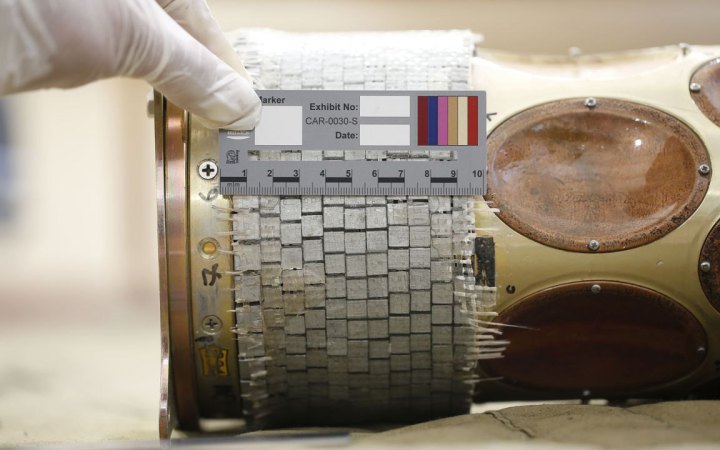Iranian kamikaze drones used in the latest attacks on Ukrainian cities are filled with European components, the Guardian writes about this with a reference to a secret document sent by Kyiv to its western allies.
In a 47-page document submitted by Ukraine’s government to the G7 governments in August, it is claimed there were more than 600 raids on cities using unmanned aerial vehicles (UAVs) containing western technology in the previous three months.
According to the paper, obtained by the Guardian, 52 electrical components manufactured by western companies were found in the Shahed-131 drone and 57 in the Shahed-136 model, which has a flight range of 2,000km and cruising speed of 180kmh.
Five European companies including a Polish subsidiary of a British multinational are named as the original manufacturers of the identified components.
Among the manufacturers are companies headquartered in the countries of the sanctions coalition: the United States, Switzerland, the Netherlands, Germany, Canada, Japan, and Poland.
According to the document, Iran has already diversified its production through the use of a Syrian factory in the port of Novorossiysk but the production of drones is shifting to Russia, to the central Tartar region of Alabuga, although Tehran continues to supply the components.
It says the Iranian government is trying to “disassociate itself from providing Russia with weapons” and “cannot cope with Russian demand and the intensity of use in Ukraine”.
According to journalists, Ukraine said it could hit drone production plants if it were given the appropriate weapons.
"Iranian UAV production has adapted and mostly uses available commercial components, the supply of which is poorly or not controlled at all,” the paper says.
Customs information is said by the Ukrainian report to show that “almost all the imports to Iran originated from Turkey, India, Kazakhstan, Uzbekistan, Vietnam and Costa Rica”.
The document also analyses the tactics and plans for drone production. It claims:
- A pause in attacks that lasted from 17 November to 7 December was “likely due to the adaptation of drones designed for a warm climate to the Ukrainian winter”, and this “may indicate additional cooperation between Russia and Iran in the production and modernisation of the Shahed-136/131”.
- Deliveries of Shahed-136/131 UAVs from Iran to Russia take place across the Caspian Sea. “From Tehran, the drones are delivered to the Iranian port of Amirabad, from where they are shipped to the Russian port city of Makhachkala.”
- The markings on the electronic components on drones used in Ukraine in recent months had been destroyed, “probably with the use of a laser”, and the Russian forces have started using the names Geranium-1 and Geranium-2 for the drones, which is “likely part of an agreement between Iran and Russia to conceal Iran’s role”.
- In early July, a new Shahed-136 model marked “Y002” was shot down in Ukraine, which “may have been assembled at a new production facility in Russia”. The sample is said to have had a different wing moulding, which “may also indicate production at a new location”.
A fuel pump manufactured in Poland by the German company Ti Automotive Gmbh, of which the British multinational TI Fluid Systems is the parent company, was discovered in a Shahed-136, as well as a microcontroller with built-in flash memory and a very low-voltage drop regulator with inhibitor made by the Swiss firm STMicroelectronics, according to the paper.
Also discovered in a Shahed-136, was an integrated circuit of a buffer network driver and a transistor made by International Rectifier, a subsidiary of the German firm Infineon Technologies AG.
TI Fluid Systems did not respond to a request for comment. Their equipment is freely available to buy from retailers across Europe and the company has previously said it does not sell into Iran.
A spokesperson for STMicroelectronics said: “We work with more than 200,000 customers and thousands of partners around the world. We do not authorise or condone the use of our products outside of their intended purpose.
In the Shahed-131 model, the Ukrainian experts identified a 14-channel, customisable integrated power management circuit and a microprocessor made by the Dutch company NXP Semiconductor and a power transistor and integrated circuit from International Rectifier.
A 32-bit microcontroller, a 32-bit processor, a microcontroller with built-in flash memory and a very low-voltage drop regulator with inhibitor made by STMicroelectronics was also found, and a GPS tracker chip made by the Swiss firm U-blox.
A spokesperson for U-blox said: “U-blox strongly condemns the invasion of Ukraine by Russia. Immediately after Russia’s invasion of Ukraine in February 2022, U-blox stopped all sales to Russia, Belarus and the territories occupied by the Russian army in Ukraine, irrespective of the intended use. Recently, U-blox has also decided not to sell to members of the Eurasian Economic Union (a free trade zone with Russia).
A spokesperson for NXP Semiconductor said it was seeking new ways to avoid the misuse of its technology.
Bart Groothuis, an MEP who sits on the European parliament’s defence and security subcommittee, said there had been insufficient coordination among the EU’s intelligence services to grapple with the misuse of western components.
“I think many European intelligence agencies aren’t even looking at sanctions,” he said.
In early August, Prime Minister Denys Shmyhal said that parts from 50 countries, including the G7, were found in Russian missiles and drones manufactured during the full-scale invasion.
Prior to that, Air Force spokesman Inna said that Russia was still able to produce high-precision cruise missiles because it was able to circumvent sanctions and obtain the necessary components.








